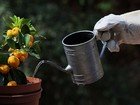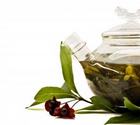Growing Herbs Indoors in Containers on Windowsills for Indoor Herb Gardens
Growing Herbs Indoors. Is it Possible?
In fact, chervil is a herb that will grow better indoors than outdoors. However, that is not to say that your herbs will grow well in some dark, forgotten corner. Herbs must have some light, reflected sunlight or warmth on them for some part of the day, that is why windowsills are perfect for growing herbs.
If you wish to encourage growth re-pot your store-bought herbs into a larger container. The ideal place to grow your herbs is on a kitchen windowsill. As long as they are away from the steam and cooking of a hot stove. Above the kitchen sink is perfect because you never forget to water them! However, if you have a sun room, atrium or solarium herbs will grow equally well there too.
Of course, if you have a window box these are also perfect for growing herbs indoors and create both useful and visually interesting indoor herb gardens in your house. This is especially so when the herbs flower, as is the case with the chives, pictured below.
You can design an indoor herb garden that has interest where your window boxes can be suspended either inside, or outside, but remember that some herbs like basil are frost-tender and if it is winter and you live in a cold climate it is best to grow this herb indoors. During the summer basil will take off and have another growth spurt, but tends to slow down in winter when grown indoors.
You can also grow herbs in hanging baskets. If you have somewhere to hang it, preferably outside where it can catch the sun, plant trailing thyme, rosemary, marjoram, and in the center plant upright sage and parsley or chives.
If you have a large hanging basket, plant trailing nasturtiums as the leaves and flowers can both be used in salads, and the seeds can be pickled for capers.
But what happens if you live in an apartment with very little light? You can still grow indoor herbs! However, you will need to buy a herb growing kit that will provide you with everything that you will need to grow your herbs. This includes grow lights, the seeds, nutrients and the pod where you grow the plants. Basically, these growing kits work using aero hydroponics technology.
The Best Herbs for your Indoor Gardens and Containers

Large growing herbs should be avoided as part of your indoor herb garden and they would be better growin outdoors. Examples of large growing herb plants are borage, lovage, angelica, comfrey, horseradish and tansy.
The easiest herbs to grow indoors in containers are parsley, chives, lemon grass, Vietnamese coriander and Thai basil.
But of course there is no point in planting herbs that you won't eat. Choose herbs that you use often. Parsley is always a firm favorite, as well as marjoram, chives, rosemary, oregano, sage, basil, thyme and mint are probably the most constantly used in most homes.
Difficult Herbs to Grow Indoors
For those of you who have had experience in indoor gardens, we all know too well of the times where we have either created the cardinal sin of either over-watering or indoor plants, or neglecting them until they wilt before our eyes. So if you have a poor memory, or just a very busy person who doesn't water their indoor plants regularly, rather stick to the easy herbs to grow.
More difficult herbs for growing in containers are Italian basil, sage, marjoram and cilantro because they are sensitive to being over-watered and also susceptible to diseases like mildew. Allow these plants to dry out between waterings.
If you are growing herbs in containers for the first time, start with the easy herbs first, and then progress to the more difficult ones, once you have the right growing conditions.
Conditioning your Plants for Growing Herbs Indoors
After that, bring your plants inside for a day, and then return them to the low lighted area outside for another day. Increase the time that they spend inside before re-potting them. In this way, you are slowly acclimatising your plants to a life of low light which they may not have been used to in the past. If you don't do this you run the risk of shocking your plant whereby it will not recover, and it will die.
The Best Soil for Growing Herbs in Containers
Because your indoor herbs will be grown containers they cannot search for any more nutrients than what you have already supplied them with. So therefore, your soil for growing herbs indoors successfully has to be the very best. Do not use commercial potting mix.The best soil for indoor herb gardens can be made by taking 3 parts of good garden loam, 1 part of moistened peat moss, and 1 part coarse river sand. Added to this should be some well-rotted farmyard manure or compost.
In addition to your organic material, you can add the following to every 8 liters of soil:
1/2 cup Epsom salts
1/4 cup coffee grounds (rinse them clean)
4 egg shells (dried and crushed to powder)
To get air into your soil and to make it lighter, add some granular polystyrene. A couple of cupfuls to your containers should be enough. Adjust according to the size of the container, but can make up 1/3 of the volume. Don't add too much as it is a water-repellent, and unless you add extra peat moss, you will find that your soil will dry out quicker than you want.
Finally I always add a good handful of blood and bone to give the herbs a good start in their pots.Best Growing Conditions for Growing Herbs Indoors
As already mentioned, window boxes are ideal for growing herbs indoors in containers. These can be either wooden, terracotta or plastic, each of which will result in you having to water differently. Terracotta does not retain moisture very well, and as such you will have to water your herbs more often that you would if there were in a plastic container.
To create humidity it is better if you stand your window box in a tray that is layered with gravel, crocks or small stones. Make sure that your window box or any other container used for planting up has drainage holes.
If your herb container doesn't have drainage holes your soil will go sour and your plant will remain with wet feet and eventually die. Therefore, if there are no drainage holes in the container, you will have to make them yourself.
Ideally, for a window box drainage holes should be spaced 5-8 inches apart. To prevent the soil from escaping out of the bottom, line the window sill or container with fine wire netting first or place a layer of stones larger than the holes at the bottom.
If you are growing herbs in containers with their own saucers make sure that you have a layer of small stones, crocks or gravel between the pot and the saucer. This is to ensure raising the humidity level but also to prevent the herb pots from becoming water-logged.
At no time should the herbs be sitting in pools of water for any length of time. Water until the water drips out, then throw the excess water away in the saucer. Don't over-water your indoor herbs. This is one of the enemies of growing herbs indoors in that many of us just kill them with kindness. Herbs are hardier than you think.
Growing Herbs Indoors - Conclusion
From time to time, if it is at all possible, move your indoor herbs outdoors to get some fresh air and a little indirect sunshine.
Don't over-expose them to the strong sunlight as they won't be used to this and they could burn. However, a little bit of dapple light or indirect light will be just the thing to give them a little boost and to keep disease down.
With some love and attention, indoor herb gardens are a great addition to any kitchen or home, and make it very easy for the cook or home nurse to just cut a stalk or pull a few leaves to add to that special dish to grab for those herbal tea recipes.
Growing Kits, Seeds and Accessories for Growing Herbs Indoors




You can Add your own Ideas on Growing Herbs Indoors Here!
We have lots of pages where you can contribute to throughout this homesteading website. We love hearing from our readers, and hope you will be one of those we hear from too. Look around our homesteading website. If you have any tips, advice or additional information that you would like to share on growing herbs indoors, please send it in! All you need to do is type and we will do the rest.
Leave a Comment
Do you have anything that you would like to add after reading this page? We would love to hear your thoughts. If you can add additional information to what has been written here you will be adding value to the website! No need to have any special skills - just type and submit. We will do the rest!
Don't miss out on our latest news and articles. Sign up for our free monthly e-zine!
Go from Growing Herbs Indoors to Growing Herbs
Go to How to Grow Herbs
Go to Herbal Tea Recipes
Go to Country Living










New! Comments
Do you have something of value to add? Leave me a comment in the box below.